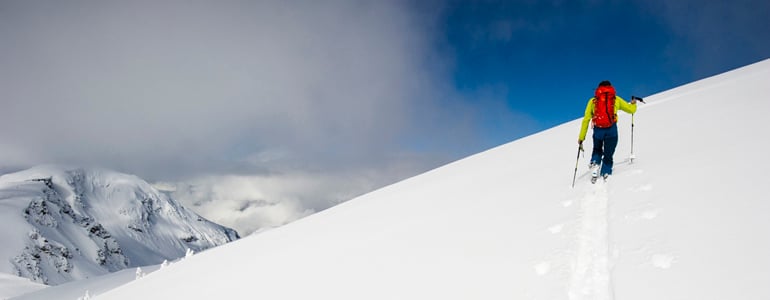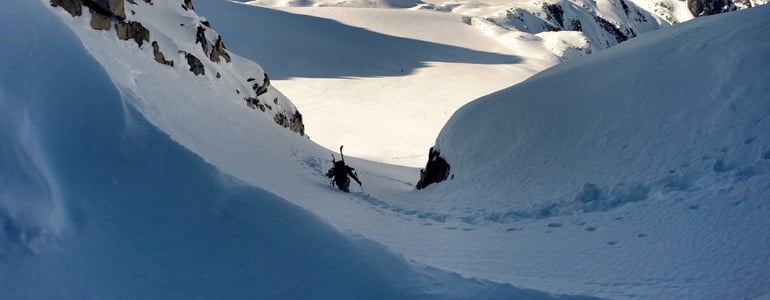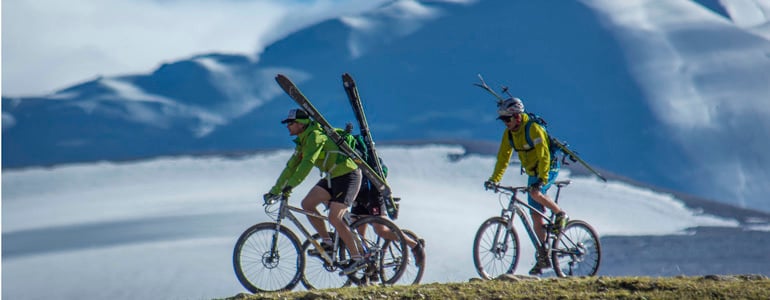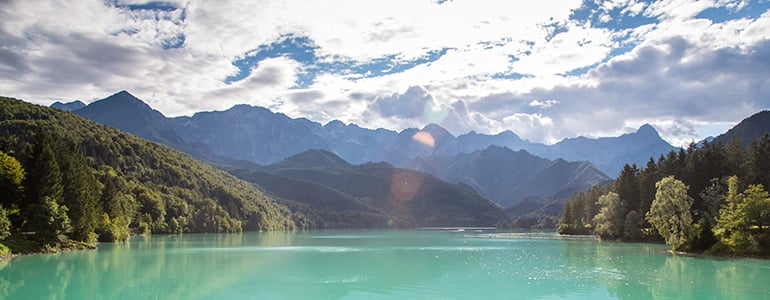

Suunto Blog

TRACKING BACK WITH AN AMBIT
Last August Estonian ski mountaineer Argo Mere attempted to ski down 7,546 m high Muztagh Ata on the northern edge of the Tibetan Plateau in China. Unfortunately the weather conditions didn't make reaching the summit easy: Mere and his group had already spent two nights at camp 3 at 6,800 m but the weather stayed poor.
“We were waiting for an opening to continue to the top, but zero visibility and continuous snowfall blocked the way up,” he says.
Finally the team decided to turn back.
“On the human side, nothing was left undone but nature wasn’t in our favor this time,” he says.
Descending in a total white-out wasn’t easy either.
“Since I was the only one on skis I had problems waiting for the others. Looking at the track now I can see that somehow I turned too much right.”
Once Mere realized he was off track – and too close to the big cliffs (dark on the map on skier's right) – he decided to escape back up the same way he had skied down.
“I put my skins back on, turned my Suunto to Trackback and managed to return to the right track and also found my friends.”
Mere says they found their previous camp thanks to his Ambit’s Track back function.
“Yes, it was quite adventurous and nice that a 'gadget' turned to something vital in returning,” he adds.
HOW TO TRACK BACK WITH AN AMBIT
In the story above Argo Mere used the Ambit’s Track back function. With Track back, you can retrace your route at any point during an exercise.
To track back during exercise:
While you are in a sport mode, keep [Next] pressed to access the options menu.
Press [Next] to select NAVIGATION.
Scroll to Track back with [Start Stop] and select with [Next].
You can now start navigating your way back the same way as during route navigation.
During navigation, press [View] to scroll the following views:
The full track view showing the whole route
Zoomed-in view of the route. (By default, the zoomed-in view is scaled to a 200 m/0.125 mi scale, or larger if you are far away from the route. You can change the map orientation in the watch settings under GENERAL / Map.)
Waypoint navigation view
You can read more about navigation in your watch’s user guide. The user guide for your product can easily be found in register after you have registered your product in the same location.
NOTE: If the GPS accuracy setting of your sport mode is Good or lower, while navigating GPS accuracy switches to Best. Battery consumption is therefore higher.
You can get support for your Suunto product at support
Main image ©John Hill / Flickr

March Madness, surviving an avalanche and his winter goals: Greg Hill shares all.
If there's one person who looks forward to the arrival of winter, it's Suunto ambassador Greg Hill. Last winter he pulled off the incredible feat of skiing 100,000 vertical meters in a month. But after breaking his leg in Pakistan this summer, he says he's looking to just hang and enjoy the mountains this winter. Below, he talks about his accident and how he can't believe he pulled off the March Madness project. Winter is coming. Excited? I love winter! I am apprehensive because I can't really say how it will go. I know I will need some boot work to ensure comfort with my newly healed leg. But I also know that my passion is still intact and ready for more adventures.
How's the leg? The leg is getting better every day, but still a long road ahead. I will be 90% at the start of the season but the last 10% will take me some time. As it stands I am walking with a slight limp and can go for short hikes.What happened? What happened was that I was overtaken by my desire for more. We had hiked up a great 5,500 m summit, that was previously unclimbed. Our line up was a decent line and would have made for a great descent. But my desire for exploration led me to try and ski a different line down. It was also a better line for filming. I liked the backdrop and figured it would look great on video. So because they were filming I skied it with less caution, since caution doesn't look as good as confidence on video.
Greg Hill doing what he does best – ski mountaineering in his local hills. ©Bruno LongAnd the lesson there? To stick to my way of skiing regardless of video. Safety is always first priority, not looking good on video. I sure didn't look good as the avalanche chased me down and took me out. Lots of people would say it was the law of averages but I seriously know that had I followed my typical rules I would have been fine.
March Madness was an incredible success. I guess you'd prefer to remember 2014 for that? Honestly, I can't believe I pulled that off, to think that I was able to average over 3,000 m up a day for a month is a little mind-boggling. Even though I did it, it's hard to imagine although I do know what drive and desire can do. Am psyched on the success of that month and can't wait to get back to 100% and onto another challenge.Recovery juice: Greg gets some home made smoothie down. © zooom.at/Markus Berger
What's been the recovery process?I have had physio 2-3 times a week, plus some swimming but also I have been road biking more than anything. Road biking is the best way to get my fitness back while also working on ankle movement and leg strength. The new Ambit3 Peak is a real motivator to push my fitness.What are your winter goals?I probably won't be able to pull off any extraordinary feats this winter but I will still seek out mountains I have not skied and adventures where I can. This accident has taught me a lot and I am keen on taking this learning and continuing to push myself in the mountains. My passion is still as strong as ever.Main image top: zooom.at/Markus Berger

How to use HR to stay safe in the mountains
Thought your HR monitor was just a training tool for fitness? Think again. It's actually an invaluable guide to staying safe in the mountains, says Mountain Guide Fabien Meyer.
Heart rate monitors are most commonly associated with performance sports and are an invaluable tool to improving your fitness, training intelligently and gauging your progress. But not many people realize they can help you make the right decisions in the mountains – decisions that could ultimately save your life.
“If you're not acclimatized your heart rate will be about 20bpm above normal.”
How so? Heart rate data can provide an accurate guide as to whether you're acclimatized. That in turn will tell you whether you're moving fast enough to make that summit in time before the weather turns. “You can use heart rate to see if you're going to make the summit,” says Meyer, who's based in Chamonix. “If you're not acclimatized your heart rate will be far above your normal rest rate. So if you're ascending 500 m per hour normally (same activity, same weight, in your home place) at 70-80% of your HR, you will be at a heart rate of more than 85-90% of your max HR. That's going to be too high to sustain. You'll go into your lactic window after five minutes and after 30 minutes you will be obliged to slow down. And because of acidity you can not hope to come back at the same efficiency.”
Using HR will help you acclimatize more effectively. ©zooom.at/Ulrich Grill
He gives the example of the classic Whymper Couloir route in the Mt Blanc massif. It's south-facing so parties have to move fast to be able to make the summit and get off in time. A heart rate monitor will help you make an informed decision as to whether you can make it.
“You have to go quite fast and ascend 400m per hour for 4-5 hours. Using heart rate you can quickly see if you can make it in a good state.” He adds that training with heart rate also works as a powerful incentive to fuel your climbing goals. Climbing is all about efficiency and moving quickly in difficult terrain, he explains. “If you do the same trip you did a month ago but with a 10% lower heart rate that's a great motivation.”
Fabien Meyer is a Mountain Guide based in Chamonix, France.
Top image ©Bruno Long
READ MORE
This is how Kilian Jornet prepares for Everest
Greg Hill's mountain rules
7 tips to accelerating your uphill speed

Exploring Alaskan couloirs
Corky Still, 35, is the 4th and final winner of our #SuuntoAdventure selfie contest. Here, the Alaskan tells us about his journey from telemark racing to exploring remote mountain lines to ski.
How does it feel to win? Great! I'm very honored to have a person of Greg Hill's caliber select my photo.Tell us about the photo? I was up early getting some turns in at Hatcher Pass, a great local spot, before work. The picture is a GoPro shot of our midwinter sunrise here in Alaska.
Corky's winning shot of an Alaskan sunrise, as selected by Greg Hill. What are your sports? I am a skier. I like to Nordic, Alpine, and Tele ski during the winter months. During the summer I spend my time cycling, rafting, and running.
So how did you get started? I grew up in Alaska ski racing for local clubs and schools. During college in Reno, I got into backcountry and big mountain skiing around Lake Tahoe. I ended up competing in the 2009 Telemark Big Mountain series where I garnered podium finishes and won the event at Alyeska Resort, AK. Since then, I have spent most of my time in the mountains around my home in Anchorage, Alaska. I continue to look for ski lines hiding right here in my backyard, while also traveling to and exploring far away places.
Tell us about a recent adventure you're proud of:I was very happy with all of the new couloirs I was able to ski last spring. That really has me excited for the upcoming winter season. More recently, I ran the Lost Lake Trail race, which is a 16 mile run through the mountains. I didn't get much preparation, but managed a good time anyway. At least I was happy with it.
Features you'd most like to use from the Ambit3? I am excited to use the altimeter tracking on the watch. I have always wondered about specific elevations when I'm out skiing and I think it will be neat to track the amount of climbing and descending during those long tours.What's next? The next few months will be spent preparing for the snow to arrive. Fall around here always involves flyfishing and running, though I will be road riding a lot to prepare for a cycling trip to the Big Island of Hawaii in November.
Check out Corky's other shots on his Instagram profile
All images ©CorkyStill

Avalanche on Shishapangma
We're sad to report that two climbers attempting to climb Shishapangma have died in an avalanche near the summit. We had earlier shared on these pages how Benedikt Böhm, Sebastian Haag and Andrea Zambaldi were attempting to climb two 8,000ers within a week. We had supported them with product.
“At 06:55 local time on 24th September, Sebastian and Andrea were caught in an avalanche at 7.900m, just 100m below the summit and were dragged for 600m vertical, over steep glaciers, into another section of the mountain,” a statement read on their website. The full report can be read here.
Haag, Böhm und Zambaldi at the start of their trip in Kathmandu. © Elias Lefas
Benedikt attempted to search for the pair with Ueli Steck, who was not part of the expedition but was climbing with Benedikt. Unfortunately the two were not able to reach the avalanche debris zone and were forced to turn back.
Our thoughts go out to their family and friends.

Mother nature left us hungry for more...
Trent Busenbark is a seasoned outdoorsman based in the US. He's also the proud winner of our #AdventureSelfie contest, winning an Ambit3 Sport. How does it feel to win? It’s always nice to see some appreciation for an image you personally captured, especially in today’s world where almost everyone has access to a camera. I am grateful for the consideration. Tell us about the photo.This photo was captured last September in Montana on a backcountry archery hunt. The original intentions were to bivy out for multiple days. On day one we packed in 15 miles (24 km) and the next day we were greeted with plummeting temps, severe wind, and driving snow. This photo was captured with a GoPro on our evacuation out of the mountains. Mother Nature and the rough terrain definitely got the best of us that trip but left us hungry for more. Plans are in place to return.
Trent's winning selfie.What gets your adventure blood pumping? For the most part my hobbies include virtually anything outdoors from horseback riding to skiing. There seems to have always been a heavy focus on hunting and photography. I'm a passionate outdoorsmen with a common goal – get out there as much as possible and always try to capture the moment. Tell us about a recent adventureI recently returned from Italy and enjoyed spending a couple days in the Dolomite Mountains. The views were fantastic! Another Montana trip is planned for November and is sure to present its own challenges.
Features you'd most like to use from the Ambit3?I am excited to use the GPS feature on the Ambit3. In Montana my Sunnto Core with its compass and altimeter proved vital in reading our topo map. It will be nice to leave specific waypoints along the way with the GPS feature. What's next? Towards the end of September I will be heading to Canada for a waterfowl outing and I will be returning to Montana for a late season elk hunt in November. If I am lucky I would like to squeeze in a ski trip this winter as well.
All images ©Trent Busenbark. Follow him on Instagram.














































































